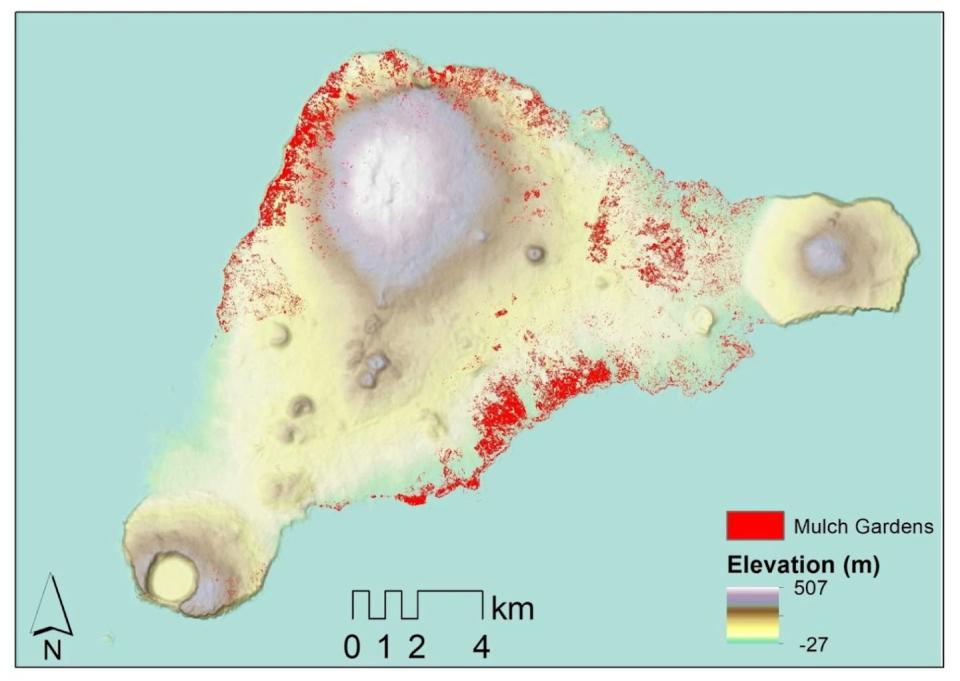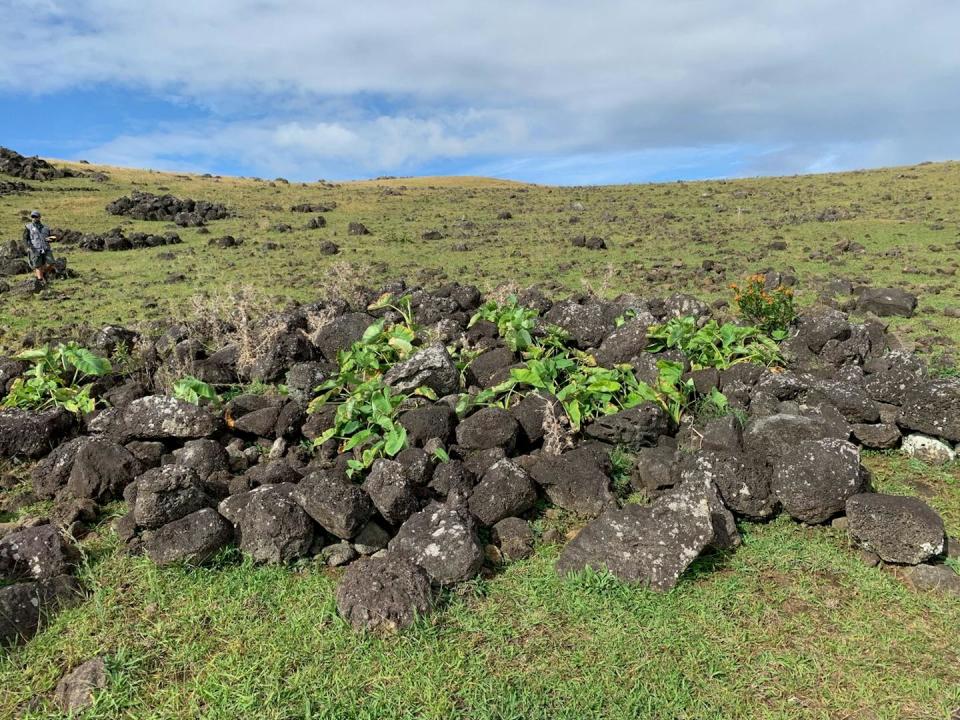Conventional wisdom holds that the island of Rapa Nui, also known as Easter Island, once had a large population that went bankrupt after living beyond their means and stripping the island of its resources. A new search that my colleagues and I conducted dealt another blow to that notion by using artificial intelligence to analyze satellite data about piles of rocks on this small island in the middle of the Pacific Ocean.
Our study looked rock gardensa form of subsistence agriculture, and determined that the island – just 15.3 miles (24.6 km) long by 7.6 miles (12.3 km) at its widest point – probably never supported much more than the approximately 3,000 people that European explorers encountered in 1722.
O popular knowledge arose from speculation about another set of stone structures on the island: the iconic huge statues, called moai, which the ancestors of the Rapanui people carved. The statues reach the height of a three-story building and weigh up to 70 tons. There are almost 1,000 of them across the island.
For an archaeologist, the mystery of what led people to invest so much time and energy into building these colossal figures begs for an explanation. For the past 24 years, my colleagues and I have been searching for one.
Some early European visitors assumed that the island must have supported a much larger population at one time to explain the number and magnitude of the moai. This assumption has been repeated for generations and forms the basis of a collapse narrative.
The story of the collapse states that the island must have once had tens of thousands of inhabitants needed for the work involved in carving and transporting the enormous statues. Such a large population was not sustainable, and ultimately food shortages resulted in famine, war, and even cannibalism. Consequently, the population fell to the meager numbers observed by early European explorers.

In our previous island studies My colleagues and I asked ourselves: if there were so many people living on the island at some point before Europe arrived, where is the evidence? We carried out a new study to examine whether such a large population was possible, given how the Rapanui people used rock gardens to grow much of their food. From our assessment of the available data, our best estimate is that there was never more than 3,000 to 4,000 peopleand they lived sustainably on the island.
What rocks say about agriculture
In this study, we examine the archaeological record of how the Rapanui used rock gardening to grow their main crop, sweet potatoes. Rock gardening is a form of farming in which broken pieces of rock are added to the soil to enrich it. Extensive rock garden farmlands are found throughout the island and would have provided a critical source of food, augmented by marine resources.
Previous studies have looked at the extent of these gardens and concluded that these efforts may have supported up to 16,000 people. Our fieldwork, however, found that many of the areas this study identified as rock gardens were incorrectly identified. Therefore, we needed to perform a more detailed analysis to get a better estimate of rock farming, which would give us a more reliable source of information about the maximum possible population size.
We combine fieldwork with new satellite image analyses. During our fieldwork, we looked for clear examples of rock gardening in the field. We knew we were in rock gardening spots when we found rock-covered patches in places that couldn’t easily be explained as the result of erosion. Obsidian artifacts among the rocks confirmed that the areas were used for cutting and processing sweet potatoes. Often these areas have another root crop, taro, that grows in them to this day. We also identified sites that may have resembled straw gardens, but were merely rocky outcrops or random scatterings of boulders and boulders.
We then acquire WorldView-3 satellite imagery for the entire island. The WorldView-3 satellite collects high-resolution visible-light photos of the Earth’s surface and images that record shortwave infrared information. Shortwave infrared includes wavelengths ranging between 900 nm and 2,500 nm, longer than those visible to the human eye. Shortwave infrared is useful for distinguishing materials that appear identical to the naked eye. In particular, shortwave infrared is sensitive to moisture differences, an essential attribute of productive agricultural fields.
Using our field data, we train machine learning models to distinguish gardening areas that are mulched from those that are not. Machine Learning generates an algorithm that can detect subtle differences – and can do so repeatedly and systematically. This way, we could survey almost the entire island quickly and without spending years doing field mapping.


Our analyzes have drastically reduced the total island area that can be associated with rock gardening, from a range of 1.6 to 8.1 square miles (4.3 to 21.1 square kilometers) to 0.29 square miles (0 .76 square kilometers). When we entered the productivity estimates for these areas, our calculations showed that the maximum number of people this form of farming can support is about 3,000quite similar to the conclusions we reach other sources of information.
Resilience instead of arrogance
Over the past 20 years, researchers have generated significant new evidence about Rapa Nui’s archaeological record, contributing to reframing the island narrative far from idea of collapse. For example, studies by my team show that the statues were moved by walking from the quarry to their final locations on platforms called ahu. We also addressed the question of how the islanders placed giants multiton hats called pukao on top of these statues.
However, the idea that there were much larger numbers of people on the island remains entrenched in academic and popular literature. The persistence of this idea has consequences outside the field of Rapa Nui archaeology. Despite archaeological evidence to the contrary, it is not uncommon, for example, for ecologists to use Rapa Nui as a case study of so-called Malthusian demographicswhere it is assumed that the population reached a massive spike that momentarily outstripped the island’s resources and triggered an ecological catastrophe.
While my colleagues and I agree that it is essential to be concerned about the potential exploitation of natural resources, catastrophe is not the only possibility. Human history offers many examples that demonstrate how it is possible to live sustainably despite restrictions.
On Rapa Nui, we learn that its people did not suffer a population collapse before the arrival of Europeans, but rather succeeded due to their ingenuity. The Rapanui people found clever ways to adapt to the island and practiced sustainable agriculture to support themselves. This research project adds details about the ability of rock gardens to grow food and support the island’s population.


Our growing understanding of the island has critical implications for the future. By learning how to thrive in a limited environment, society can adopt strategies used by people in the past. The archaeological record of Rapa Nui points to the idea that efforts that bring communities together cooperatively and competitively, such as carving and transporting moai, lead to greater resilience in times of scarcity.
In the end, the story of Rapa Nui is not a cautionary tale but a source of inspiration that could be the key to the future of humanity.
This article was republished from The conversation, an independent, nonprofit news organization that brings you trusted facts and analysis to help you understand our complex world. It was written by: Carl Lipo, Binghamton University, State University of New York
See more information:
Carl Lipo receives funding from the National Science Foundation and the National Geographic Society’s Lasting Impacts: Sustainability Archeology Program.


































